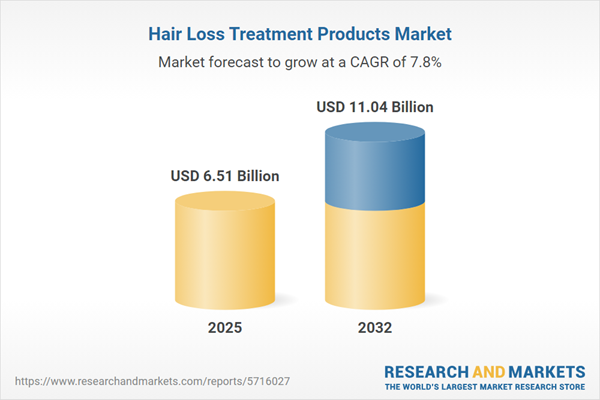Speak directly to the analyst to clarify any post sales queries you may have.
The hair loss treatment products market is undergoing significant transformation as new technologies, shifting demographics, and changing customer expectations drive innovation. Senior leaders seeking sustainable growth must stay ahead of sector disruptions, balancing agility with long-term strategic planning.
Market Snapshot: Hair Loss Treatment Products Market Overview
The global hair loss treatment products market is marked by robust expansion, with value growing from USD 6.03 billion in 2024 to USD 6.51 billion in 2025. This upward trend is set to continue, with projections pointing to nearly USD 11.04 billion by 2032 and a CAGR of 7.83%. Key growth factors include a rising aging population, integration of digital health platforms, and advancements in clinical and personalized care pathways. Executive attention is also required due to the growing demand for transparent product efficacy, evolving consumer needs for tailored solutions, and a regulatory landscape that varies by region. These forces challenge market players to evolve their strategies and leverage data-driven decision making while maintaining compliance and competitive edge.
Scope & Segmentation
- Product Type: Injection-based therapies, such as mesotherapy, platelet-rich plasma, and steroid-based options, deliver targeted treatments. Laser interventions are split between professional in-clinic applications and home-use devices. Oral solutions, including prescription agents like dutasteride and finasteride, combine with advanced supplements to address various stages of hair loss. Surgical solutions, encompassing hair transplants, scalp micropigmentation, and scalp reduction, meet advanced or chronic cases. Topical products provide clinically validated actives—like minoxidil and finasteride—paired with botanical blends to suit diverse preferences.
- Distribution Channel: Multiple channels—including beauty salons, clinical providers, hospitals, e-commerce, and traditional pharmacies—support segmented access and reflect varied consumer preferences and trust sources.
- Gender: Strategies incorporate gender-specific factors and psychological considerations, enabling alignment with prevalent hair loss patterns, motivations, and outcome expectations among men and women.
- Age Group: Targeting spans youth under 30, adults aged 30–45, and individuals over 45, supporting customized technology and communication approaches that reflect each segment’s attitude toward product adoption and brand engagement.
- Regional Markets: The Americas, Europe, Middle East & Africa, and Asia-Pacific form the key geographic segments. In Asia-Pacific, there is a pronounced adoption of technology-first solutions and value-sensitive purchasing behaviors. Europe, the Middle East & Africa require integration of local regulatory and cultural nuances. Americas markets emphasize scale and established health systems.
- Leading Companies: Market innovation is led by Johnson & Johnson Consumer Inc., Church & Dwight Co., Inc., L'Oréal S.A., Unilever PLC, Procter & Gamble Company, Merck & Co., Inc., Galderma S.A., Hims & Hers Health, Inc., Pierre Fabre S.A., and Henkel AG & Co. KGaA, each driving benchmarks through sustained investment.
Key Takeaways for Senior Decision-Makers
- Incorporating digital health tools and minimally invasive modalities is improving diagnostics and accelerating treatment delivery, encouraging more personalized care pathways.
- Increasing complexity in the regulatory environment is compelling companies to enhance their investment in clinically substantiated solutions, helping build trust and ensure compliance.
- Effective growth strategies must remain responsive to local regulations and regional consumer behaviors, as new therapies often intersect with established treatments and traditions.
- Personalized marketing tactics and tailored product formulations, supported by nuanced communications, are proving critical for customer retention and loyalty programs.
- Research into biologics, cellular techniques, and targeted acquisitions is bolstering competitive positioning, with forward-thinking companies adapting quickly to technological advancements.
- Operational continuity is increasingly dependent on resilient, adaptable supply chains designed to absorb market volatility and external shocks, supporting sustained performance as dynamics shift.
Tariff Impact: Navigating Regulatory and Trade Disruptions
Primary impacts from U.S. tariffs on hair loss treatment importers have led enterprises to modify sourcing and production strategies. Supplier diversification and alternative raw material sourcing are enhancing cost control and helping companies maintain product innovation investments, even in uncertain regulatory climates.
Methodology & Data Sources
The findings leverage published scientific literature, clinical research, patent reviews, and regulatory analysis, supplemented by direct expert interviews with dermatologists and industry specialists. Data triangulation underpins actionable insights tailored for executive decision makers in the hair loss treatment products market.
Why This Report Matters
- Empowers leaders to develop multi-year product and investment strategies that align with technological and consumer trends.
- Facilitates informed decision making in supply chain optimization, market entry, and competitive benchmarking in a dynamic environment.
- Delivers comprehensive, segment-wise analysis highlighting both established and emerging competitors to shape stronger overall strategy.
Conclusion
To ensure ongoing relevance and advantage in the hair loss treatment products sector, executive teams should focus on clinical advancement, operational flexibility, and customer-centric engagement. This report offers a structured basis for strategic planning as industry transformation accelerates.
Additional Product Information:
- Purchase of this report includes 1 year online access with quarterly updates.
- This report can be updated on request. Please contact our Customer Experience team using the Ask a Question widget on our website.
Table of Contents
3. Executive Summary
4. Market Overview
7. Cumulative Impact of Artificial Intelligence 2025
List of Figures
Samples

LOADING...
Companies Mentioned
The key companies profiled in this Hair Loss Treatment Products market report include:- Johnson & Johnson Consumer Inc.
- Church & Dwight Co., Inc.
- L'Oréal S.A.
- Unilever PLC
- Procter & Gamble Company
- Merck & Co., Inc.
- Galderma S.A.
- Hims & Hers Health, Inc.
- Pierre Fabre S.A.
- Henkel AG & Co. KGaA
Table Information
| Report Attribute | Details |
|---|---|
| No. of Pages | 186 |
| Published | October 2025 |
| Forecast Period | 2025 - 2032 |
| Estimated Market Value ( USD | $ 6.51 Billion |
| Forecasted Market Value ( USD | $ 11.04 Billion |
| Compound Annual Growth Rate | 7.8% |
| Regions Covered | Global |
| No. of Companies Mentioned | 11 |









